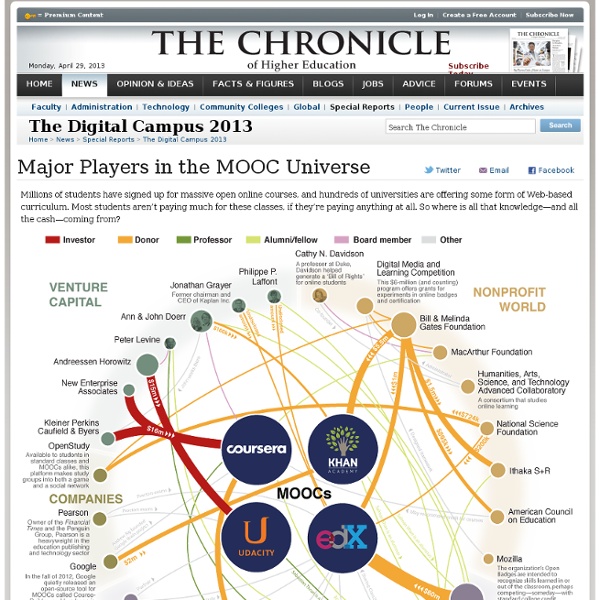



Khan Academy en Français | Bibliothèques Sans Frontières moocStarter digiSchool - Création de MOOC à la demande Call for Contributions Final extension submission deadlines: Papers: 17th of February 2014 Projects – Workshops: 24th of February 2014 Contributions (papers and projects) to the conference should focus on one or more of the following areas: We are seeking scientific paper submissions, as well as proposals for interactive workshop sessions such as learning café sessions, debate formats, thematic table workshops, etc. Attendance at the conference is subject to a conference fee (rates will be published soon) and requires registration through the conference website, as places are limited. We welcome submissions of three different kinds. 1. 2. 3. Project presentations are short contributions of on-going initiatives and European projects. Overview of the important dates:
Enseigner et former avec le numérique » Le cours est assuré par un collectif d’auteurs de différentes institutions. Il est coordonné par Éric Bruillard, professeur des universités à l'école normale supérieure de Cachan, pour l’institut français de l’éducation. Le cours est sous la responsabilité des école normales supérieures de Cachan et de Lyon. Plusieurs auteurs sont membres de ces deux ENS : Pierre Bénech (ENS Lyon), Matthieu Cisel (ENS Cachan), Mehdi Khaneboubi (ENS Lyon), Isabelle Quentin (ENS Lyon), Françoise Tort (ENS Cachan). Les autres auteurs viennent de différentes institutions et régions de France : Jacques Audran (INSA Strasbourg), Georges-Louis Baron (université Paris Descartes), Béatrice Drot-Delange (université Clermont 2), Cédric Fluckiger (université Lille 3), Caroline Ladage (université d’Aix-Marseille), Marie-Joëlle Ramage (université Paris 11), Christophe Reffay (université de Besançon), André Tricot (ESPE Toulouse), Emmanuelle Voulgre (université Paris Descartes).
eLearn2 : Se former en ligne pour former en ligne - Ouverture Le 3 novembre 2014 - Vous pouvez vous inscrire ICI (directement « on the MOOC ») - On recherche des animateurs occasionnels (de module) … les participants de la Saison 1, vous venez ? Cette année 2014-2015, la formation eLearn2 sera organisée exclusivement sous la forme d’un MOOC (Massive Open Online Course) de nature connectiviste. Il s’agit pour nous d’expérimenter cette formule d’apprentissage collectif avec l’idée centrale que : pour construire une formation en ligne, il faut avoir vécu une telle formation. Un MOOC connectiviste, ça tient à la fois d’une communauté d’apprentissage et d’une communauté d’échange de pratiques. L’espace de la formation sera proposé sur la toute nouvelle plateforme Claroline Connect (Consortium Claroline). Brièvement nous vous proposons : Acquis d’apprentissage à l’issue de la formation : Par ailleurs, vous aurez eu l’occasion de Concrètement, notre espace de xcMOOC proposera : A. 1. B. Et quels rôles pour chacun(e) ? Comme cela va-t-il se passer ?
France Université Numérique : de nouvelles mesures pour développer les MOOCs A la veille de l’ouverture des premiers MOOCs, cours en ligne ouverts à tous, Geneviève Fioraso a annoncé de nouvelles mesures pour développer les MOOCs en France. Les MOOCs (Massive Open Online Course) sont des cours en ligne, ouvert à tous, qui se déroulent avec plusieurs milliers d’apprenants simultanément. Ils associent des ressources numériques (vidéos, textes, images...) et des activités pédagogiques (quiz, forum, réseaux sociaux, tutorat, évaluations...). Le 2 octobre 2013, Geneviève Fioraso avait lancé la première plateforme numérique française de MOOCs, France Université Numérique. Dès le 16 janvier 2014, les étudiants, mais également les lycéens, les salariés, les demandeurs d’emploi, toutes les personnes désireuses d’apprendre et de se former, pourront suivre, gratuitement et à leur rythme, les 8 premiers MOOCs sur France Université Numérique. En 2014, H.E.C., l’E.N.S. financer l’équipement des campus en "fabrique de MOOCs".
L’annuaire des MOOC Francophones... Késako ? Le site web « Mooc Francophone » est un portail destiné aux cours en ligne ouverts à tous, en langue française. Il a pour vocation d’informer les visiteurs des offres disponibles et de leur proposer un ensemble de critères pour faciliter le choix d’un cours. L’annuaire des MOOC Francophones est né de quelques observations très simples : - Il est difficile de trouver le MOOC sur le web dont on a besoin… - Il n’existe pas d’espace où les offres de cours sont mutualisées… - Il n’existe pas d’espace permettant d’évaluer la qualité des cours en ligne… - Il n’existe pas d’espace pour les retours d’expériences des participants… L’ambition est de contribuer activement à la construction d’un écosystème avec l’ensemble des concepteurs de MOOC (universités, grandes écoles et entreprises) par la diffusion d’un retour d’expérience des participants et des « bonnes pratiques ». Mooc Francophone est totalement indépendant de quelque organisme que ce soit.